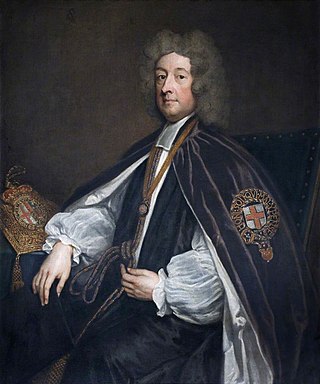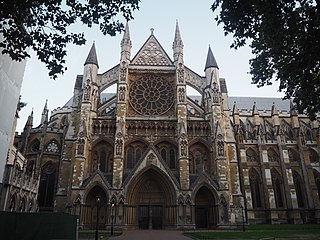Related Research Articles
The College of Chaplains of the Ecclesiastical Household of the Sovereign of the United Kingdom is under the Clerk of the Closet, an office dating from 1437. It is normally held by a diocesan bishop, who may, however, remain in office after leaving his see. The current Clerk is James Newcome, Bishop of Carlisle. In his role as Clerk of the Closet, he took part in the Royal procession at the 2023 Coronation.
Richard Field (1561–1616) was an English ecclesiological theologian associated with the work of Richard Hooker. Whereas Hooker, eight years Field's senior, had written his Lawes of Ecclesiastical Polity to defend conformity against non-conformity, Field's major work, Of the Church (1606/10), was a defence of the Protestant Church of England under its Elizabethan settlement against the charge of Romanist opponents that it was no church at all.

William Talbot was an English Anglican bishop. He was Bishop of Oxford from 1699 to 1715, Bishop of Salisbury from 1715 to 1722 and Bishop of Durham from 1722 to 1730.

Matthew Wren was an influential English clergyman, bishop and scholar.

Philip Bisse was an English bishop.

Edward Stanton (1681–1734) was an English stonemason, builder and sculptor.

The Church of St Andrew, Holborn, is a Church of England church on the northwestern edge of the City of London, on Holborn within the Ward of Farringdon Without.

Zachary Pearce, sometimes known as Zachariah, was an English Bishop of Bangor and Bishop of Rochester. He was a controversialist and a notable early critical writer defending John Milton, attacking Richard Bentley's 1732 edition of Paradise Lost the following year.
Henry Bagshaw D.D. (1632–1709), was an English divine.
John Newey was an English churchman, Dean of Chichester from 1727 to 1735.
John Fulham M.A. (1699–1777) was an English cleric, Canon of Windsor from 1750 to 1777 and Archdeacon of Llandaff from 1749 to 1777
John Mandeville was a Canon of Windsor from 1709 to 1722 and Dean of Peterborough from 1722 to 1725.
Dr Penyston Booth,, also Peniston Booth, was an 18th-century Anglican priest, who hailed from the minor gentry, and served as Dean of Windsor from 1729 to 1765.
Maurice Vaughan was a Canon of Windsor from 1695 to 1722
William Harward DD was a Canon of Windsor from 1562 - 1589.
Michael Stanhope DD (1681-1737) was a Canon of Windsor from 1730 to 1737
William Fleshmonger(? -1541/42), the son of a Winchester College tenant, was born in Hambledon, Hampshire. He was a Doctor of Canon Law and Dean of Chichester during the turmoil of the English Reformation.
References
- ↑ Dictionary of British Sculptors 1660-1851 by Rupert Gunnis p.367
 This article incorporates text from a publication now in the public domain : "Manningham, Thomas". Dictionary of National Biography . London: Smith, Elder & Co. 1885–1900.
This article incorporates text from a publication now in the public domain : "Manningham, Thomas". Dictionary of National Biography . London: Smith, Elder & Co. 1885–1900.